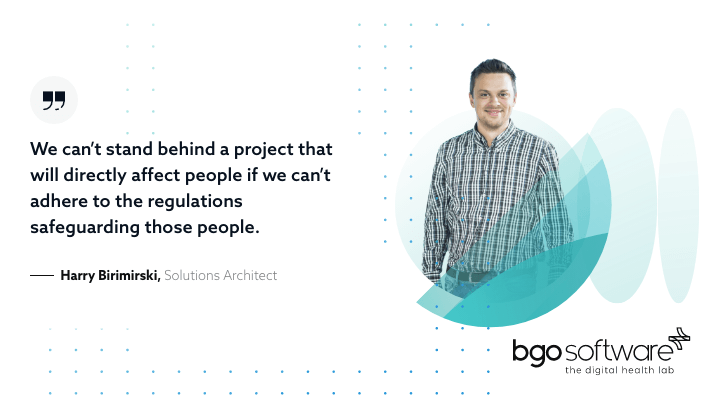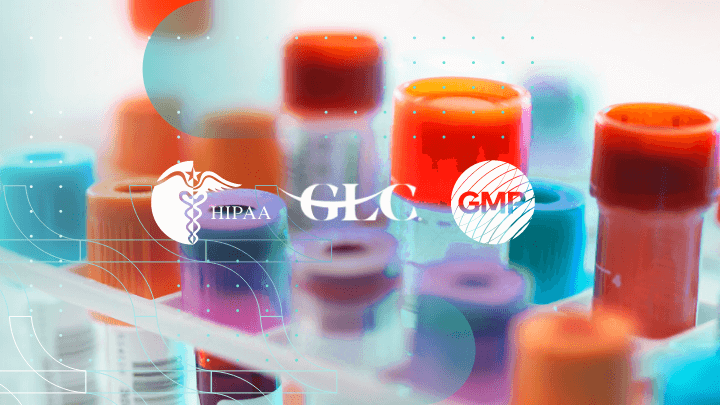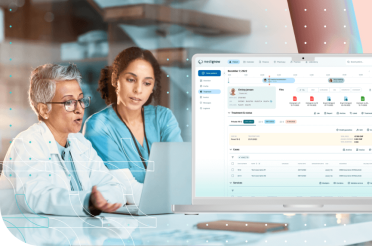The development of software for any type of purpose can be a challenge given how many different aspects of the process have to be considered. This fact is especially true for pharmaceutical software because there are a lot more factors to be kept in mind.
One of the biggest to account for is that all pharmaceutical technology, including software, has to undergo rigorous audits and be completely compliant with regulations.
BGO Software as a company that has had many projects that are intended for the medical industry, has undergone such regulatory processes many times. In order to learn even more, however, the company has brought in an expert in the field and one who has worked with BGO on a multitude of different projects – Solution Architect Harry Birimirski.
He explains the roles of audits in the development process of such software and how different regulatory roles are crucial for it.
The importance of audits
Audits have a bad reputation usually because of their inquisitive nature. A lot of people would say that audits are like tests and everyone is afraid of getting a bad grade or failing. But they are not meant for that.
Audits have to exist in order to ensure a quality standard for the products that people will be using. The pharmaceutical industry is highly regulated, but justly so. Pharmaceutical software is no exception to this as its functionality will determine the future outcome of the manufactured products.
Regulations like Good Manufacturing Practices (GMP), Good Laboratory Practices (GLP), and Good Clinical Practices (GCP) set very strict standards for the development, validation, and use of software in pharmaceutical processes.
Audits ensure that software systems comply with these regulations, reducing the risk of non-compliance issues and associated penalties. Audits aren’t in their own right meant to enforce penalties or set them but rather warn a company of potential faults in their systems so that such things can be corrected before there is a need for a penalty.

Navigate Audits with ease with industry expert insights.
Understand regulatory requirements to learn to tackle the challenges for both internal and external audits by seeking expert advice.

Another invaluable side of the auditing process is that it works to ensure patient safety. Pharmaceutical software often plays a direct or indirect role in patient safety. For instance, software may control the manufacturing processes of pharmaceuticals or manage patient data.
Audits help identify and rectify vulnerabilities and errors that could compromise patient safety. Thankfully the regulations that are responsible for this safety are very clear and their implementation as well.
The documentation that audits entail
“Most things are documented through electronic signatures, but everyone can see who has which qualifications and even with what grade.”
One of the most important aspects of properly conducting audits is the documentation.
“If it’s not documented it didn’t happen.”
Everything needs to be documented in order to ensure the integrity of the information. Meticulous documentation is a cornerstone of effective audits. Every aspect of the audit, from observations to findings, must be systematically recorded to create a transparent and traceable audit trail. This documentation serves as a vital resource for communication among team members, regulators, and other stakeholders, fostering a shared understanding of the audit’s scope and outcomes.
Beyond facilitating communication, thorough documentation acts as a safeguard in case of disputes or inquiries. It provides a reliable record of the audit process, allowing auditors to substantiate their assessments and demonstrate compliance with established standards. In essence, meticulous documentation is not just a procedural necessity; it’s a fundamental element that underpins audit quality, accountability, and transparency.
There are a couple of key factors documentation allows audits to account for:
- Traceability. In the pharmaceutical industry, it’s essential to have a clear and auditable trail of actions and data. Documenting audits provides evidence to trace the development process, changes, and any potential issues.
- Risk management. Audits are a key component of risk management in pharmaceutical software development. They help identify, assess, and mitigate risks associated with software, including technical, regulatory, and business risks. Documenting all of this gathered data can be beneficial for future decisions as mistakes and achievements from the past can be given as examples.
- Validation. Pharmaceutical software often requires validation to demonstrate that it performs as intended. Audits support the validation process by identifying areas where validation is needed and ensuring that the validation protocols are correctly executed. Successful validation needs to be carefully documented in order to not only be referenced but be proof of correctly conducted procedures.
Regulatory roles and how they work
“There are inside auditors that hold different regulatory roles. And while inside audits have a re-do, they are not in any way less strict.”
Regulatory roles are by far one of the more significant parts of making sure the software that is being developed won’t fail at the audit and regulation stage. Such roles are intended to be filled by certain people inside the company with the necessary qualifications.
There are many different roles and together with our expert Harry, we take a closer look at them.
One of the first we examine is the role of regulatory compliance assessment. Regulatory roles are involved in assessing the software’s compliance with industry-specific regulations, such as GMP, GLC, the Health Insurance Portability and Accountability Act (HIPAA), and other relevant standards.
They help identify regulatory requirements and ensure that software development activities align with these standards.
Another important role in a regulation department is quality assurance. This role encourages the implementation of quality management systems, such as ISO 13485, to maintain product quality and safety. These roles may participate in audits and inspections to assess software quality.
Furthermore, there is the function of post-market surveillance. In cases where the software is already in use, regulatory roles may be responsible for post-market surveillance. They monitor the software’s performance in real-world settings and ensure that any adverse events are promptly addressed and reported.
As we have talked about previously, an important part of the entire regulatory process is documentation. Accurate and complete documentation is essential for audits and regulatory submissions.
This collection of important data is essential in conducting and facilitating audits to ensure that the software development process complies with regulatory requirements. Inspections such as these have to be taken seriously because of their inherent challenging nature. We will take a look at exactly how a company can be better prepared for the challenges audits pose.
The challenges of audits and how to be ready
“Audits can be difficult for any company, but the auditors are still people. They can be fair and strict, but both with good reason.”
There are two types of audits which are inside and outside ones. Both have their differences in the way the process is conducted and the impact of their respective results. Our expert provides some key insight into those differences.
Harry Birimirski has directly worked with BGO Software on various products, the most recent one being a software solution that collects, analyses, and reports global manufacturing data. The company faced many different challenges, but even after the completion of the project, the developers had to account for both types of audits, which can be a challenge in its own right.

Ensure the success of your next audit with expert guidance.
Use audits to comply with regulations and guarantee patient safety by learning how to identify the potential errors of your manufacturing process.
The first kind – the inside inspection – is in a way more lenient, according to Birimirski, as it is intended to show potential weaknesses in the preparation and certain points of the project that do not adhere fully to regulation.
An inside audit focuses on completely different questions as well. Inside inspectors pay more attention to whether the technologies listed in the documentation are present and accounted for and also if they are properly functioning.
Our expert does share that even though inside auditors are meant to test everything before any outside ones arrive and give time for correction, they are still strict, but rightfully so.
The second kind – the outside inspections – are far more final as the auditors there only come once and there is no room for big mistakes and correction. A number of different penalties can be imposed that could stop the project before launch if it is not compliant.
The focus of outside auditors is represented in their questions. Instead of asking about whether the technologies are available and functioning, their queries are directed toward why the developers chose these particular technologies as a solution.
In such cases, developers can’t answer questions they don’t know. Every choice has to be carefully considered and well justified in front of inspection.
Preparing for inspections
The function of inside audits is a big part of preparing for the outside ones. Inside audits should not be taken as terminal decisions, but as a way to test what is not working as it should and see how it can be fixed.
There are a couple of ways we can prepare for audits so that they don’t seem as challenging:
- Understand regulatory requirements. Start by thoroughly understanding the relevant regulations and standards that apply to your industry, such as GMP, GLP, GCP, and HIPPA. This knowledge will guide your preparation efforts.
- Establish audit teams. Assemble internal audit teams responsible for compliance. These teams should include individuals with expertise in quality assurance, regulatory affairs, and relevant subject matter experts.
- Training and education. Ensure that your employees are well-trained and informed about compliance requirements. Invest in ongoing training programs to keep staff updated on regulations and best practices.
- Data backup and recovery. Ensure that data backup and recovery procedures are in place and tested regularly. This is critical for data integrity and system reliability.
- Continuous improvement. Regularly review your processes, training programs, and systems to ensure that they remain aligned with evolving regulatory standards.
The development of pharmaceutical software is never an easy job, but it can’t be given its importance in the industry. Such software can determine the entire success of certain medications and even patient outcomes.
That is precisely why the development of software that is intended to assist in the manufacturing of pharmaceuticals has to be handled with great care. A way to accomplish this goal is to keep on learning more about the subject and seek the guidance of professionals who have experience in the field.

Whether you’re a startup, a Fortune 100 company or a government organisation, our team can deliver a solution that works for you.
BGO Software
BGO Software is not a stranger to technology leading experts like Harry who help us understand the topic better and teach us how to be prepared for everything.









